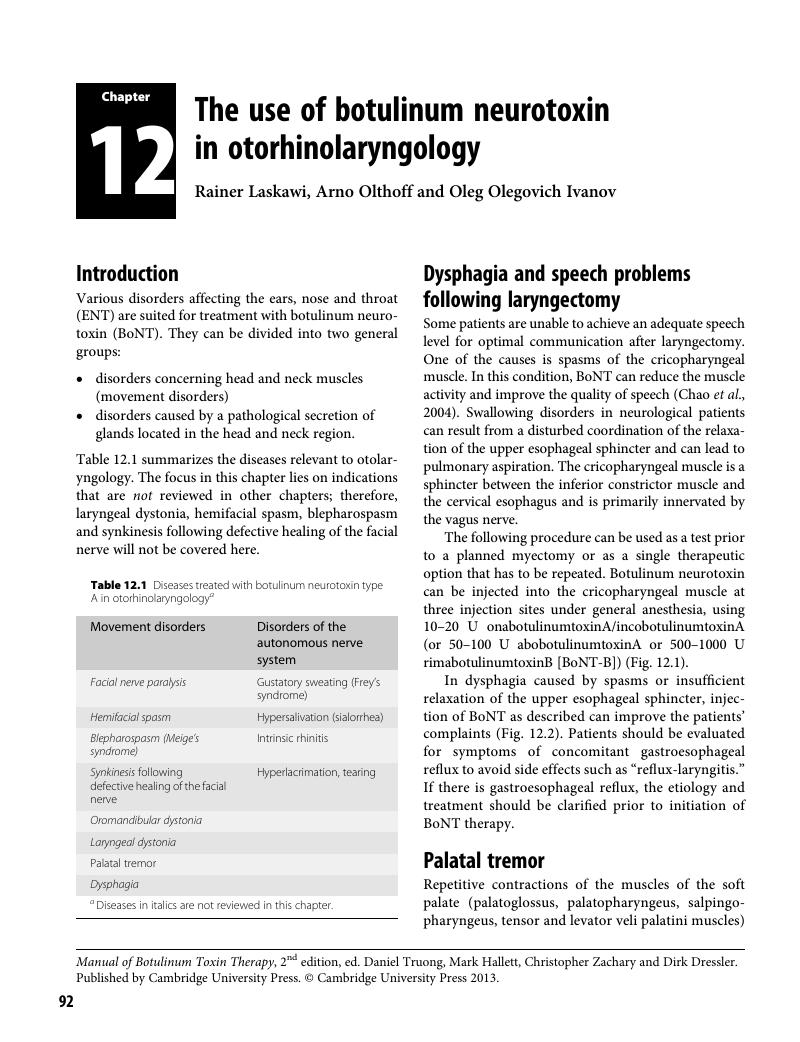Book contents
- Frontmatter
- Dedication
- Contents
- List of Contributors
- Preface
- Chapter 1 The pretherapeutic history of botulinum neurotoxin
- Chapter 2 Botulinum neurotoxin: history of clinical development
- Chapter 3 Pharmacology of botulinum neurotoxins
- Chapter 4 Immunological properties of botulinum neurotoxins
- Chapter 5 Treatment of cervical dystonia
- Chapter 6 Examination and treatment of complex cervical dystonia
- Chapter 7 Ultrasound guidance for botulinum neurotoxin therapy: cervical dystonia
- Chapter 8 Treatment of blepharospasm
- Chapter 9 Botulinum neurotoxin in oromandibular dystonia
- Chapter 10 Treatment of focal hand dystonia
- Chapter 11 Botulinum neurotoxin therapy of laryngeal muscle hyperactivity syndromes
- Chapter 12 The use of botulinum neurotoxin in otorhinolaryngology
- Chapter 13 Treatment of hemifacial spasm
- Chapter 14 Spasticity
- Chapter 15 The use of botulinum neurotoxin in spastic infantile cerebral palsy
- Chapter 16 The role of ultrasound for botulinum neurotoxin injection in childhood spasticity
- Chapter 17 The use of botulinum neurotoxin in spasticity using ultrasound guidance
- Chapter 18 The use of botulinum neurotoxin in tic disorders and essential hand and head tremor
- Chapter 19 Treatment of stiff-person syndrome with botulinum neurotoxin
- Chapter 20 Botulinum neurotoxin applications in ophthalmology
- Chapter 21 Cosmetic uses of botulinum neurotoxins
- Chapter 22 Hyperhidrosis
- Chapter 23 Botulinum neurotoxin A treatment for ischemic digits
- Chapter 24 Botulinum neurotoxin in wound healing
- Chapter 25 Use of botulinum neurotoxin in neuropathic pain
- Chapter 26 The use of botulinum neurotoxin in the management of headache disorders
- Chapter 27 The use of botulinum neurotoxin in musculoskeletal pain and arthritis
- Chapter 28 Treatment of plantar fasciitis with botulinum neurotoxins
- Chapter 29 Use of botulinum neurotoxin in the treatment of low-back pain
- Chapter 30 Use of botulinum neurotoxin in the treatment of piriformis syndrome
- Chapter 31 Ultrasound-guided botulinum neurotoxin injections for thoracic outlet syndrome
- Chapter 32 Botulinum neurotoxin in the gastrointestinal tract
- Chapter 33 Botulinum neurotoxin applications in urological disorders
- Index
- References
Chapter 12 - The use of botulinum neurotoxin in otorhinolaryngology
Published online by Cambridge University Press: 05 February 2014
- Frontmatter
- Dedication
- Contents
- List of Contributors
- Preface
- Chapter 1 The pretherapeutic history of botulinum neurotoxin
- Chapter 2 Botulinum neurotoxin: history of clinical development
- Chapter 3 Pharmacology of botulinum neurotoxins
- Chapter 4 Immunological properties of botulinum neurotoxins
- Chapter 5 Treatment of cervical dystonia
- Chapter 6 Examination and treatment of complex cervical dystonia
- Chapter 7 Ultrasound guidance for botulinum neurotoxin therapy: cervical dystonia
- Chapter 8 Treatment of blepharospasm
- Chapter 9 Botulinum neurotoxin in oromandibular dystonia
- Chapter 10 Treatment of focal hand dystonia
- Chapter 11 Botulinum neurotoxin therapy of laryngeal muscle hyperactivity syndromes
- Chapter 12 The use of botulinum neurotoxin in otorhinolaryngology
- Chapter 13 Treatment of hemifacial spasm
- Chapter 14 Spasticity
- Chapter 15 The use of botulinum neurotoxin in spastic infantile cerebral palsy
- Chapter 16 The role of ultrasound for botulinum neurotoxin injection in childhood spasticity
- Chapter 17 The use of botulinum neurotoxin in spasticity using ultrasound guidance
- Chapter 18 The use of botulinum neurotoxin in tic disorders and essential hand and head tremor
- Chapter 19 Treatment of stiff-person syndrome with botulinum neurotoxin
- Chapter 20 Botulinum neurotoxin applications in ophthalmology
- Chapter 21 Cosmetic uses of botulinum neurotoxins
- Chapter 22 Hyperhidrosis
- Chapter 23 Botulinum neurotoxin A treatment for ischemic digits
- Chapter 24 Botulinum neurotoxin in wound healing
- Chapter 25 Use of botulinum neurotoxin in neuropathic pain
- Chapter 26 The use of botulinum neurotoxin in the management of headache disorders
- Chapter 27 The use of botulinum neurotoxin in musculoskeletal pain and arthritis
- Chapter 28 Treatment of plantar fasciitis with botulinum neurotoxins
- Chapter 29 Use of botulinum neurotoxin in the treatment of low-back pain
- Chapter 30 Use of botulinum neurotoxin in the treatment of piriformis syndrome
- Chapter 31 Ultrasound-guided botulinum neurotoxin injections for thoracic outlet syndrome
- Chapter 32 Botulinum neurotoxin in the gastrointestinal tract
- Chapter 33 Botulinum neurotoxin applications in urological disorders
- Index
- References
Summary

- Type
- Chapter
- Information
- Manual of Botulinum Toxin Therapy , pp. 92 - 100Publisher: Cambridge University PressPrint publication year: 2014



